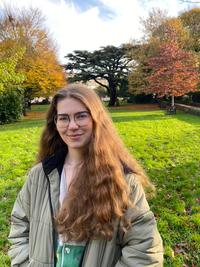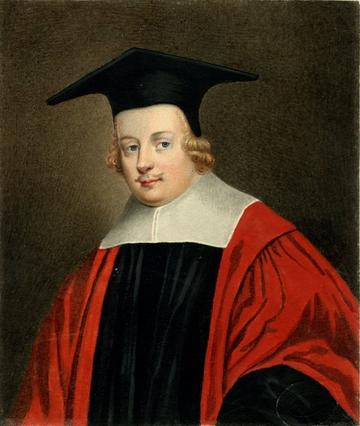Dr. Henry Hammond and the Allestree Library

Lily is in her third and final year at the University of Bristol studying Religion & Theology. Before the summer of 2022, Lily was interested in pursuing a master's degree, but having been the first in her family to go to University she didn’t know how she could feasibly achieve that goal. UNIQ+ expanded her awareness of the opportunities that were available to her and enabled her to seriously consider postgraduate study. In her undergraduate dissertation, she is researching the extent to which 16th-century Jesuit missionaries had a Christian-oriented perception of Zen Buddhists in Japan. Following this, she hopes to further explore the relationship between the east and the west, and religion and politics. Outside of academia, she is a freelance book editor and a resident advisor for first-year undergraduate students.
Located in the cloisters of Christ Church, Allestree Library is a largely unknown part of the University of Oxford. In 1681 it was founded by former Regius Professor of Divinity, Richard Allestree and houses around 3000 books, many of which were bequeathed to him by other scholars. The books cover subjects ranging from classics to mathematics, meaning that someone from any discipline could find something of interest in this unique place. However, with Allestree being a theologian, the majority of the books are about religion.
Unfortunately, the library fell largely out of use after Allestree’s death - few of its books can be dated post-1700. As a result, the library acts like a time capsule, with both its contents and appearance being almost identical to how it was in the lifetime of its founder. This presents a great opportunity for research. The library is a pure representation of academic life during the post-Reformation, and with around fifty percent of the books being annotated it allows for extensive research into individual scholars. Therefore, deepening our knowledge of Allestree Library could greatly contribute to our overall understanding of 17th-century intellectual history.

My personal research focused on the previous owners of Allestree’s books and the relationship they had with Richard Allestree. One was a notable contributor - Dr. Henry Hammond, a 17th century royalist and Anglican theologian. A good friend of Allestree, Hammond wrote the preface to Allestree’s anonymously published and bestelling ‘The Whole Duty of Man’. The pair held similar beliefs. In fact, the reason for Hammond’s immense contribution to Allestree Library (at least 138 books) was due to their shared hopes. In his will, Hammond left all of his books to Allestree, stating that this was because “in his hands they would be useful weapons for the defence of that cause he had during life so vigorously asserted”. The “cause” being referred to is the defence of the Church of England. Therefore, through Allestree’s relationship with Henry Hammond, it can be seen that one of the purposes of the library was to strengthen his existing beliefs.
However, it is not entirely clear if two of the books attributed to Hammond were actually bequeathed by him. Both were owned by a person called George Hammond, as can be seen by his name being written on the front title pages of the books Macrobii Opera by Macrobius (e.6.7) and Scholia tōn pany dokimōn eis hepta tragōdias tou Euripidou by Euripides (a.6.14). Presumably, the cataloguer assumed that George Hammond was a relative of Henry due to their connected surname. I decided to research into whether or not this was true, hoping that discovering the true identity of George Hammond could tell us more about the library or Richard Allestree himself.
My focus was on Macrobii Opera since the opening few pages of the book were annotated. Immediately this seems like a book Henry Hammond would have owned. According to Fell, who wrote a biography on the scholar, Hammond was known to spend 13 hours a day studying, could speak Greek, Latin and some Hebrew, and was particularly interested in philosophy and classics. The text is commentary on Cicero’s Dream of Scipio made by Ambrosius Macrobius. Many of the chapters deal with his own ideas about the world and the universe, blending both classics and philosophy together. Therefore, if Macrobii Opera did belong to Hammond, it would make sense. Additionally, the text and annotations are in Latin, a language in which Hammond was very proficient.
After reading the will of Dr. John Hammond (Henry’s father), it became obvious that Henry Hammond had a brother called George. Multiple times John referenced a son by this name - “I give unto my loving sonne George Hamond my lease of Triplow in Cambridgeshyre” and “I give further to the said George in money twoe hundred poundes”. However, I still found no concrete proof that this was the George Hammond I was looking for.
Henry was known to heavily annotate every book he read and Fell even stated that Hammond “drew up indexes for his private use at the beginning and end of each book”. I analysed three books from Allestree Library proven to have been annotated by Henry and found that this was the case. Each of the three books I analysed had one page folded into columns with heavy amounts of notes in each section of the page. Meanwhile, Macrobii Opera was not indexed. Additionally, I compared the book’s handwriting to Henry’s and found them not to be a match - the anonymous handwriting was a lot more round and soft than Hammond’s spikier, thinner letters. Furthermore, the books proven to be previously owned by Henry had pages with corners that appeared to be purposefully folded (perhaps to act as a bookmark), something which could also not be seen in Macrobius.
Therefore, it seemed very possible this book could have belonged to someone else. Following this revelation, I searched through archives and databases for other possible identities of George Hammond. One I came across matriculated at Exeter College, Oxford in 1641 before becoming a minister. However, he was ejected from the Church of England in 1662 following the Act of Uniformity after refusing to follow the Book of Common Prayer. This differs greatly to Richard Allestree who in 1663, after the restoration of Charles II, was made chaplain to the King and became Regius Professor of Divinity. Evidently, Allestree supported Charles II’s restoration whilst Hammond did not.
This made me consider - would it be possible that Allestree would own a book belonging to someone he disagreed with so much? When looking at Allestree Library, it appears that he did. Thomas Barlow was a staunch Calvinist in a time when it was unpopular at the University of Oxford. Allestree, on the other hand, rejected episcopalian Calvinism. Despite this, multiple of Barlow’s books ended up in his library and in the catalogue it can be seen that many books on Calvinism are kept there as well. But why?
As was made clear in Henry Hammond’s will, Allestree wished to use the library to defend his beliefs. Therefore, it seems possible that he kept books which expressed opinions he disagreed with (or books belonging to those he disagreed with) to do just so - analysing why people might think a certain way so he could demonstrate why they should not. Keeping books by an ejected minister would allow him to achieve this.
In the Netherlands, Richard Allestree’s work The Whole Duty of Man (De Gantsche Pligt van een Christen in dutch) was attributed to a George Hammond who completed an M.A. at an unknown university, and whose dates of birth and death are also unknown. However, this George Hammond was understood to have published A Discourse of Family-Worship in 1694. This would make him the minister who was ejected in 1662. It is not clear why Richard Allestree’s book was wrongly attributed to him but presumably there were overlapping expressed beliefs in the works of the two men, making the idea of a relationship more likely. As a result, the chances of Richard Allestree owning some books belonging to this Hammond are also increased.
A second George Hammond I encountered completed both his BA and MA at Brasenose College, Oxford after matriculating in 1715. Having been a deacon at Christ Church Cathedral, it wouldn’t seem impossible that he would have access to Allestree Library. However, if he was the George Hammond I’m looking for he would have been one of the last people to use it since it was rarely used after the start of the 1700s. If this was proven to be the case, further analysis into his annotations as well as any books added to the library post Richard Allestree’s death would paint a clearer picture of how the space was used to contribute to research in the 18th century, and perhaps give further insight into why it fell out of use.
Upon analysing the annotations, it is appears that this scholar was interested in renaissance humanism. The two books connected to George Hammond are classical, and on one page in Macrobii Opera Hammond writes “vide Erasmus” (“see Erasmus”). Here he is presumably referring to the 16th century Dutch humanist Desiderius Erasmus who wrote Ciceronianus (pub. 1528), a critique of the scholarly Latin which imitated Cicero’s style of writing. Therefore, it is possible that the annotator was comparing the writing in Dream of Scipio to Erasmus’ analysis of Cicero’s linguistic style. Additionally, the contemporary catalogue of Allestree Library shows that at least four of Erasmus’ works are kept there meaning that if the 18th-century George Hammond was the true annotator of Macrobii Opera he might have been using the library to research further into humanism. Further analysis of Erasmus’ books could help to confirm this.
Regardless of who George Hammond truly is, it is clear that further research into the Allestree Library could reveal so much about Richard Allestree himself as well as contribute greatly to our understanding of early modern intellectual life. With the library being frozen in time and containing over 3000 books, the number of research avenues one could go down are many and various. The place is truly a unique and rich resource for early modern historians.




